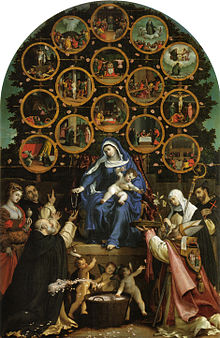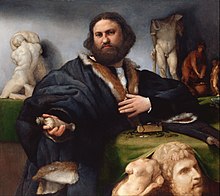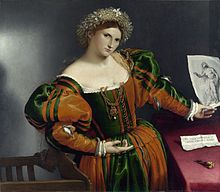Lorenzo Lotto
Lorenzo Lotto | |
|---|---|
 Possible self-portrait, attributed to Lorenzo Lotto, 1540s, Thyssen-Bornemisza Museum[1] | |
| Born | Lorenzo Lotto c. 1480 Venice, Italy |
| Died | 1556/57[2] Loreto, Marche, Italy |
| Nationality | Italian |
| Known for | Painting |
| Notable work | Polyptych of Saint Domenico |
| Movement | High Renaissance |
| Signature | |
Lorenzo Lotto (c. 1480 – 1556/57) was an Italian
Overview
During his lifetime Lotto was a well-respected painter and certainly popular in Northern Italy; he is traditionally included in
Biography
Born in
Apprenticeship
Little is known of his training. As a Venetian he was influenced by

Treviso (1503–1506)
Lotto soon left Venice, because there the competition for a young painter would have been too great, with established names such as
Recanati (1506–1508) and Rome (1508–1510)

In 1508 he began the
The Marche (1511–1513) and Bergamo (1513–1525)
In 1511 he was at work for the confraternity of the Buon Gesù in

His next works are mostly wall paintings: in 1524 he painted a series of frescoes with the lives of saints (such as Saint Barbara) in the Suardi Chapel in Trescore (near Bergamo). In the details he depicts scenes of each saint's life, such as in the fresco Martyrdom of St. Claire. In the same fresco he portrays Christ with vines sprouting from his hands, illustrating the words of the New Testament: "I am the vine, you are the branches".[3] In 1524 he also painted cartoons with Old Testament stories, as models for the intarsia panels for the choir stalls of Santa Maria Maggiore in Bergamo.
More than 20 private paintings date from the same period; they are mostly of religious and pious subjects, such as Madonnas or a Deposition, used for worship at home. Though he painted in the Classical tradition, Lotto adds a personal touch to the intense emotions. Using contrasting poses and opposing movement, he breaks the traditional symmetry of the Virgin surrounded by angels and saints.
Venice (1525–1532)

In Venice, Lotto first resided at the Dominican monastery of
As Venice was a city of great wealth and as popularity increased, he received many orders for private paintings, including ten portraits, among them, Portrait of a Young Man (
Venice, the Veneto and the Marche (1532–1556)
In this last period of his life, Lorenzo Lotto would frequently move from town to town, searching for patrons and commissions. In 1532 he went to Treviso. Next he spent about seven years in the Marche (Ancona, Macerata and Jesi), before returning to Venice in 1540. He moved again to Treviso in 1542 and back to Venice in 1545. Finally he went back to Ancona in 1549.
This was a productive period in his life, during which he painted several altarpieces and portraits.
At the end of his life, Lotto found it difficult to earn a living. Furthermore, in 1550, when he was about 70, one of his works had an unsuccessful auction in Ancona. As recorded in his personal account book, this deeply disillusioned him. As he had always been a deeply religious man, in 1552 he joined the Holy Sanctuary at Loreto, becoming a lay brother. During that time he decorated the basilica of Santa Maria and painted a Presentation in the Temple for the Palazzo Apostolico in Loreto. He died in 1556 and was buried, at his request, in a Dominican habit.
Thanks to the work of the art historian Bernard Berenson, Lotto was rediscovered at the end of the 19th century. Since then, many monographs and several exhibitions have been dedicated to Lorenzo Lotto, such as the exhibition in Venice in 1953 and one in the National Gallery of Art, Washington, USA, in 1998.
Selected works





- National Museum of Capodimonte, Naples
- Santa Cristina al Tiverone Altarpiece (c. 1504–1506). Church of Santa Cristina al Tiverone, Quinto di Treviso, Veneto
- Allegory of Virtue and Vice (1505). National Gallery of Art, Washington, USA
- Allegory of Chastity (c. 1505). National Gallery of Art, Washington
- Madonna with Child and Saints (c. 1505). Scottish National Gallery, Edinburgh, United Kingdom
- Asolo Altarpiece (1506). Cathedral of Asolo, Veneto
- Recanati Polyptych (1506–1508). Civic Museum Villa Colloredo Mels, Recanati
- Portrait of a Young Man with a Lamp (c. 1506). Kunsthistorisches Museum, Vienna
- Saint Jerome in Penitence (c. 1506). Louvre, Paris
- Adoration of the Christ Child (1508). EUROPEUM, Kraków
- Saint Joseph and the Virgin Suitors (c. 1508). Thyssen-Bornemisza Museum, Madrid[5]
- Mystic Marriage of Saint Catherine (1506–1508), Alte Pinakothek, Munich
- Borghese Gallery, Rome
- Museo nazionale di Castel Sant'Angelo
- Transfiguration (1510–1512). Civic Museum Villa Colloredo Mels, Recanati
- Martinengo Altarpiece (1513–1516), Santi Bartolomeo e Stefano, Bergamo
- Saint Jerome in Penitence, (1515). Allentown Art Museum, Pennsylvania
- Uffizi Gallery, Florence
- Portrait of Lucina Brembati (c. 1518). Accademia Carrara, Bergamo
- Madonna and Child with Saint Roch and Saint Sebastian (c. 1518). National Gallery of Canada, Ottawa
- Holy Trinity (c. 1519–20). Museo Adriano Bernareggi in Bergamo.
- Christ Taking Leave of his Mother (Lotto), Gemäldegalerie, Berlin
- Santo Spirito Altarpiece (1521). Church of Santo Spirito, Bergamo
- Adoration of the Child(1523). National Gallery of Art, Washington, USA
- Prado Museum, Madrid[6]
- Mystical Marriage of St Catherine of Alexandria (1523). Accademia Carrara, Bergamo
- Ritratto di coniugi (1524). Hermitage Museum, Saint Petersburg, Russia
- Christ Carrying the Cross (1526). Louvre, Paris
- Portrait of a Young Man with a Book (c. 1526) Pinacoteca del Castello Sforzesco, Milan
- Portrait of Andrea Odoni (1527). Royal Collection, London
- Madonna and Child with Saint Catherine and Saint James, (c. 1527). Kunsthistorisches Museum, Vienna
- Portrait of a Gentleman with a Lion Paw (c. 1527). Kunsthistorisches Museum, Vienna
- Santa Maria dei Carmini, Venice
- Palazzo Pallavicini Rospigliosi, Rome
- Venus and Cupid (c. 1530). Metropolitan Museum of Art, New York
- Saint Lucy Before the Judge (1532). Pinacoteca comunale, Jesi
- The Sleeping Child Jesus with the Madonna, St. Joseph and St. Catherine of Alexandria (1533). Accademia Carrara, Bergamo
- Portrait of a Lady as Lucretia(1533). National Gallery, London.
- Madonna with Child and Two Donors (c. 1533–1535). Getty Center, Los Angeles, US
- Recanati Annunciation (c. 1534). Civic Museum Villa Colloredo Mels, Recanati
- Holy Family with SS Jerome, Anna and Joachim (1534). Uffizi, Florence
- Holy Family with St. John the Baptist (c. 1536). Louvre, Paris
- Pietà (1538–1545). Pinacoteca di Brera, Milan
- Portrait of a Young Man, Uffizi, Florence
- Santa Maria in Telusiano, Monte San Giusto
- Madonna of the Rosary (1539). Church of San Nicolò or San Domenico, Cingoli
- Altarpiece of the Halberd (c. 1539). Ancona, Pinacoteca Civica Francesco Podesti
- Portrait of a Man with a Felt Hat (c. 1541) National Gallery of Canada, Ottawa[7]
- Bust of a Bearded Man (1541, ascribed). Fine Arts Museum, San Francisco
- Santi Giovanni e Paolo, Venice
- Portrait of Laura da Pola (1543–1544). Pinacoteca di Brera, Milan
- Portrait of an Old Man with Gloves (c. 1543). Pinacoteca di Brera, Milan
- Portrait of a Man (c. 1545) Pinacoteca di Brera, Milan
- San Giacomo dall’Orio, Venice
- Saint Jerome in Penitence (1546). Prado Museum, Madrid[8]
- Portrait of Brother Gregorio Belo of Vicenza (1548). Metropolitan Museum of Art, New York City
- Assumption (1550). church of San Francesco alle Scale, Ancona
- The Crossbowman (1551). Pinacoteca Capitolina, Rome
- Portrait of an Old man (c. 1552, ascribed). Hermitage Museum, Saint Petersburg.
- Presentation in the Temple (1552–1556). Palazzo Apostolico, Loreto
- Selfportrait (?). Thyssen-Bornemisza Museum, Madrid.

See also
- Lotto carpet, a lacy patterned Turkish carpet named for him.
References
- ^ See article on the website of the Museo Thyssen Bornemisza
- ^ "Lorenzo Lotto". Nationalgallery.org.uk. Retrieved 7 April 2018.
- John15:5
- ^ "Museo Diocesano". 2.chiesacattolica.it. Retrieved 7 April 2018.
- ^ "Saint Joseph and the Virgin's Suitors". Museo Nacional Thyssen-Bornemisza. Retrieved June 11, 2020.
- ^ "Marsilio Cassotti and his Wife Faustina - The Collection - Museo Nacional del Prado". www.museodelprado.es. Retrieved June 11, 2020.
- ^ "Search the Collection". Gallery.ca. Retrieved 7 April 2018.
- ^ "Saint Jerome in Penitence - The Collection - Museo Nacional del Prado". www.museodelprado.es. Retrieved June 11, 2020.
Sources
- Benezit E. Dictionnaire des Peintres, Sculpteurs, Dessinateurs et Graveurs; ISBN 2-7000-0156-7(in French)
- Turner J. ISBN 1-884446-00-0
- Ricketts Melissa - Maestros del Renacimiento (in Dutch Translation : Grote meesters uit de Renaissance; Rebo International BV, 2005 ISBN 90-5841-089-7)
- Benesch, Otto (December 1957). "New Contributions to Lorenzo Lotto". Burlington Magazine. 99 (657): 410–413.
- Berenson, Bernard - Lorenzo Lotto; The Phaidon Press
- Kaap, Henry - Lorenzo Lotto malt Andrea Odoni: Kunstschaffen und Kunstsammeln zwischen Bildverehrung, Bildskepsis, Bildwitz, Berlin, Gebr. Mann Verlag 2021. ISBN 978-3-7861-2865-6
- Lorenzo Lotto: Rediscovered Master of the Renaissance, by David Alan Brown, Peter Humfrey, and Mauro Lucco, with contributions by Augusto Gentili et al. Washington, D.C.: Catalogue of the exhibition in the National Gallery of Art; New Haven: Yale University Press, 1997.
- Humfrey, Peter - Lorenzo Lotto; New Haven, Yale University Press, 1997; ISBN 0-300-06905-7(the first full-length study of Lorenzo Lotto since the monograph of Bernard Berenson)
- Zanchi, Mauro - Lotto. I simboli, Giunti, Firenze 2011. ISBN 88-09-76478-1
External links
- Lotto's paintings in various museums of the world
- Lorenzo Lotto: rediscovered master of the Renaissance
- Painters of reality: the legacy of Leonardo and Caravaggio in Lombardy, an exhibition catalog from The Metropolitan Museum of Art (fully available online as PDF), which contains material on Lotto (see index)
